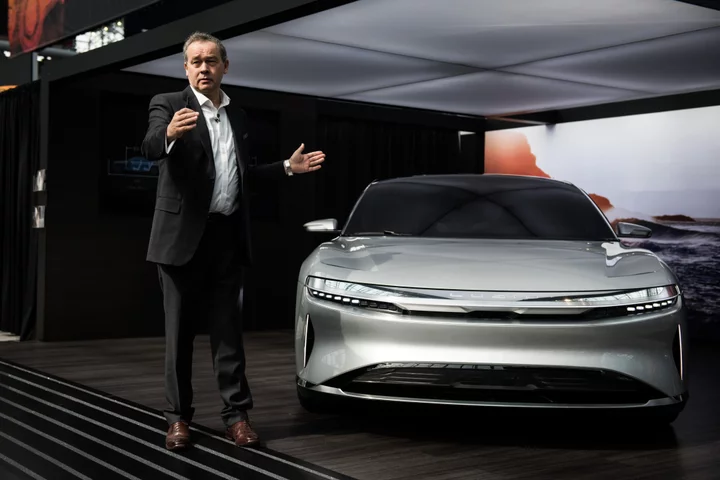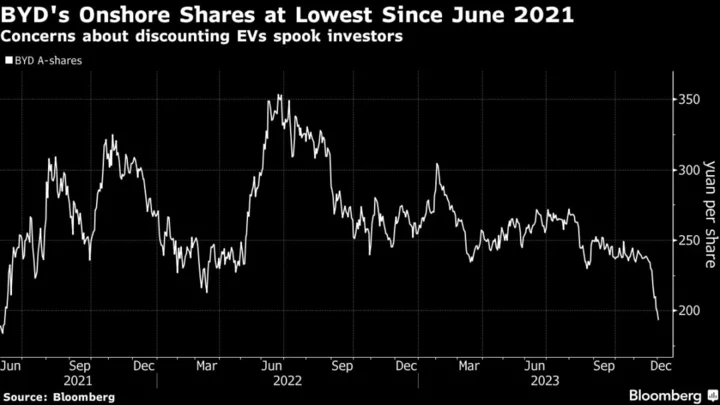Reaction to Tesla Inc. getting other automakers to switch charging standards has run the gamut, from the fawning to the dismissive.
“It’s just a plug,” Cowen analyst Gabriel Daoud wrote earlier this month, after General Motors Co. followed Ford Motor Co. in agreeing to make the jump. Two days later, Dan Ives of Wedbush compared investor excitement about Tesla’s charging business with when Wall Street began to realize the potential of Amazon Web Services — an $80 billion a year business.
Count Peter Rawlinson among the questioners. The chief executive officer of Lucid Group Inc. brings first-hand knowledge to the discussion — as chief engineer of Tesla’s Model S, he was personally involved in the design of what the company recently started calling the North American Charging Standard, or NACS: a slimmer connector than what the rest of the industry has been using.
“What we’re really comparing is, is it a screw cap or is it a cork on the bottle, not the quality of the wine,” Rawlinson said in an interview, at one point echoing Daoud word-for-word. “It’s rather bizarre.”
Before Tesla fans cry foul and accuse Rawlinson of bias — he and Elon Musk aren’t exactly chummy — know that he’s quick to call Tesla’s Supercharger network more reliable than competitors. He doesn’t rule out Lucid moving to NACS. In fact, he said the carmaker probably will eventually.
But it will have to be on the right terms, he said, and he had some choice words for manufacturers that have boarded the Tesla charging bandwagon before its connector has been standardized.
“If you’ve got the most advanced technology in the world, you’re a bit reluctant to risk that,” Rawlinson said, referring to Lucid. “If you haven’t got the most advanced technology in the world, you’re not really incentivized to tread that warily.”
Actually Open?
Part of Rawlinson’s qualms about adapting NACS now speak to the reality that Musk’s recent charging coups are substantive, even if likening its charging offerings to AWS is a stretch.
It’s true that NACS merely refers to the skinnier connectors and ports that Tesla customers use to recharge, rather than the bulkier Combined Charging System plugs, or CCS for short. When Tesla released its design and specifications late last year, inviting charging network operators and automakers to use its connector and port, the company described it as “purely [an] electrical and mechanical interface.”
What’s been giving Rawlinson pause is whether NACS truly is open. While Tesla said back in November that it was actively working with organizations to codify its charging connector as a public standard, SAE International — formerly named the Society of Automotive Engineers — announced only just this week that it was starting an expedited process to standardize NACS.
One reason this matters: access to consumer data, from credit card information to how often vehicles’ batteries are charged and driving cycle details.
“Whoever controls this — if it isn’t an open, impartial standard, if it’s owned by one company — has access to a lot of consumer data,” Rawlinson said. “It’s who owns that data, and making it genuinely open-sourced, that would worry me.”
Tesla didn’t immediately respond to an emailed request for comment.
What Matters
There’s another element to Rawlinson’s bemusement about the amount of attention Tesla’s charging deals are getting. To paraphrase a Musk-ism — the best part is no part — the Lucid boss says the best fast-charger is no fast-charger.
Rawlinson believes government funding for charging infrastructure ought to be directed to slower charging overnight — think apartment dwellers who park in basement garages.
“Why do you have an EV? Partly because it’s better, but partly because you care about the environment,” he said. “The best thing for the environment is to have the power stations running more evenly on a 24-hour cycle. The worst thing for the environment is going charging daytime when the factories are running, everybody’s cooking.”
The bipartisan Infrastructure Investment and Jobs Act that President Joe Biden signed into law in November 2021 included $7.5 billion in support for EV charging. The White House has said that federally funded fast chargers will be required to include CCS connectors.
“What matters is that there is a standard that everyone can use, that it’s an open standard, and given there is taxpayer money involved, that it’s future-proof and reliable,” Rawlinson said.









